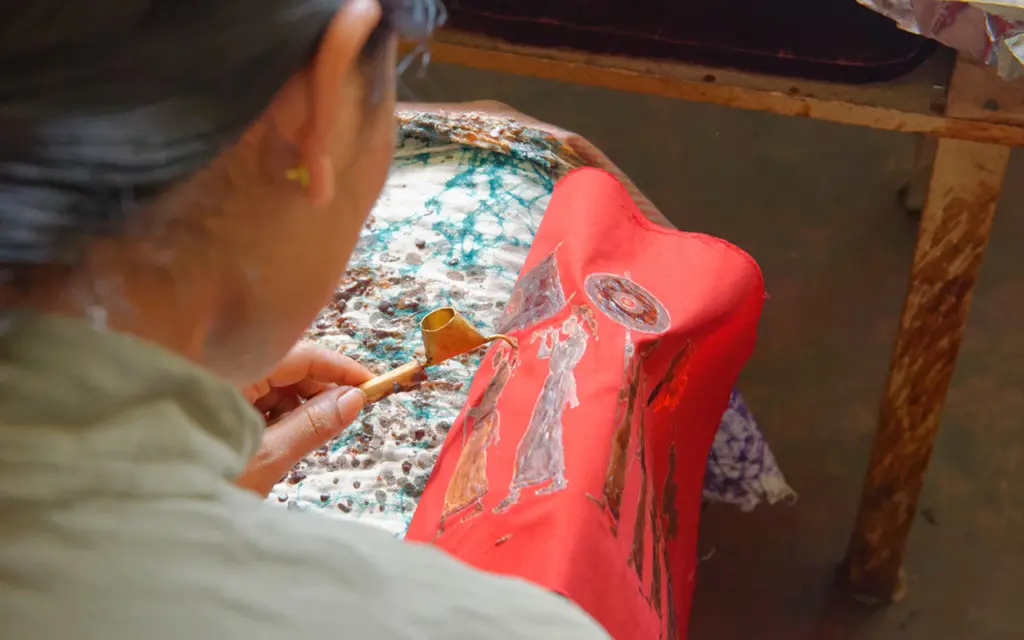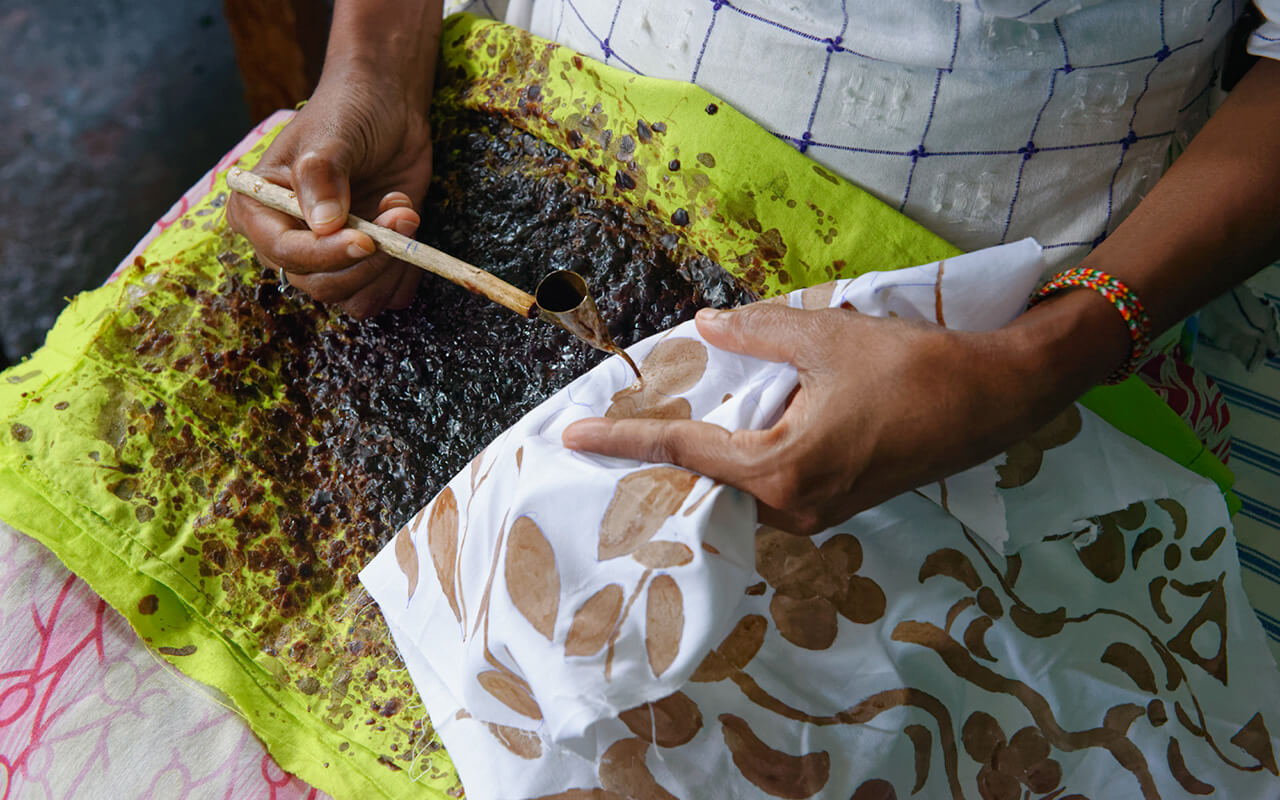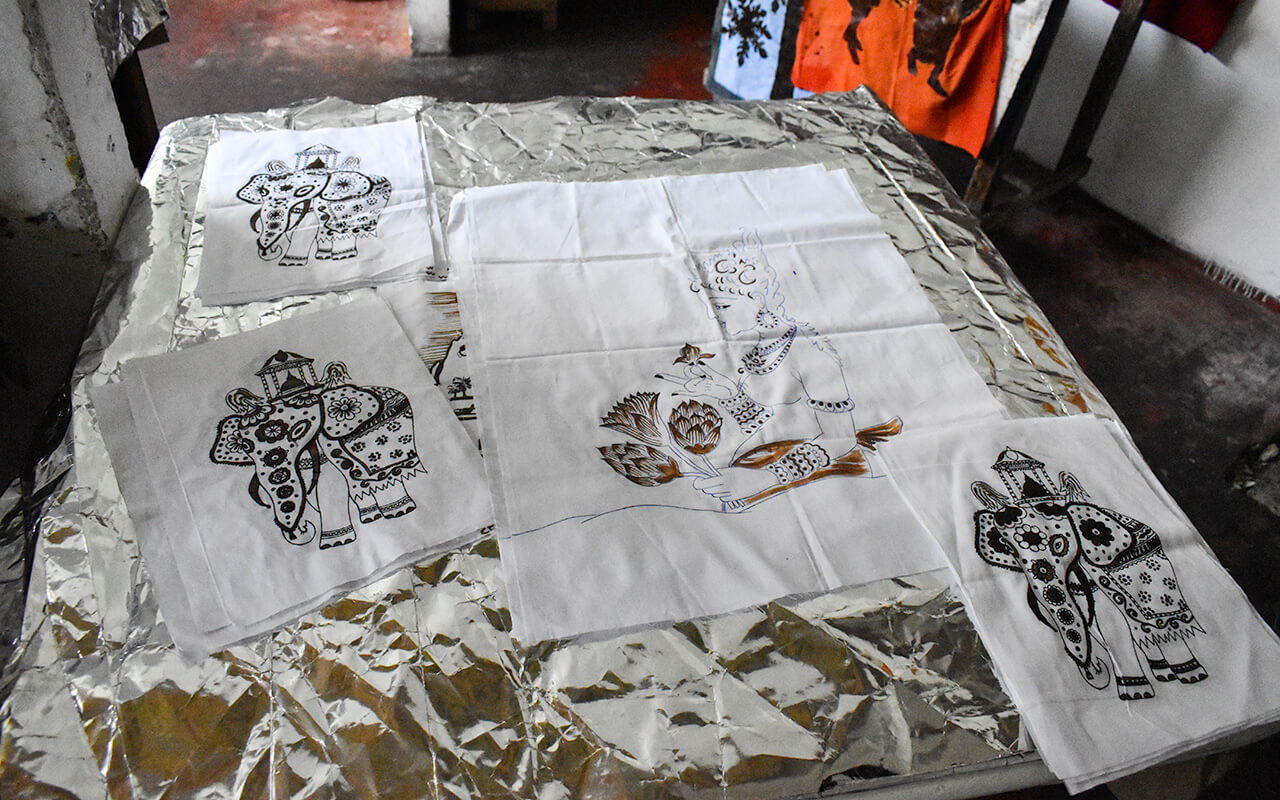Kandy is a former royal capital in Sri Lanka and is, therefore, an important centre for Arts & Crafts. Following a day visiting the Temple of the Tooth Relic, some exploration of handmade crafts was in order. As a fabric addict, I was keen to discover an ancient yet contemporary technique for fabric transformation: the Art of Batik! Visiting a Kandy batik factory is a great opportunity to discover this intricate technique.
What is Batik?
Batik is a very time-consuming handmade technique where hot wax is applied to the fabric before dyeing. Once the wax is dry, the fabric is dyed and the wax boiled off. This process is repeated several times, in order to create a design with several colours. A simple batik might have one or two colours, however, a more complex one will show a range of colours with more advanced designs.
Fabrics suitable for batik are cotton and silk, any synthetic fibre would burn in the process. Also, you need to set the colour in the fabric between each dyeing, and natural fibres are best for that. Between each dye, you must let the fabric dry, and sunshine brightens the colours! In this labour of love, the number of colours is an indicator of how much work was required. The more colours there are, the more time it takes and the artisans at the Kandy batik factory can work on a single piece for hours on end.
A Brief History of Batik
Without going too deep into the details, you probably know batik from Indonesia… You know those beach clothes and sarongs from Bali? Maybe it’s a distant memory or one you prefer to forget, but you know the style I mean…
The technique of Batik likely originates from Ancient Egypt or Sumeria, however, it spread across South East Asia and some parts of Africa. The Dutch introduced batik to Sri Lanka and it developed its own style.
Batik Today
In Sri Lanka, batik is a reasonably large industry, with factories or small workshops, which produce large quantities of batik clothes, decorative homewares and pictures. Modern chemical dyes expand the range of colours available. It is still very much a handmade technique, where Sri Lankan ladies spend hours applying hot wax to pieces of cotton or silk cloth.
The slightly disappointing thing is that most of the “modern” designs come from Java… A lot of it is representations of elephants or Buddha statues. It’s a shame, in my view, because there is plenty of good design in Sri Lanka. A great thing would be to combine a designer and the skills within the Kandy batik factory.
The work of the ladies in the workshop is remarkable but the style doesn’t really rock my boat. I wish I’d found more contemporary designers using this ancient and delicate technique. If you know of good modern places where the Art of Batik is refreshed, please let me know!
There are other handmade handicrafts to explore in Sri Lanka to help with your shopping choices. If you are interested in other handmade experiences in Sri Lanka, please read my posts about a tea factory and a spice garden. Another great visit around Kandy is the Peradeniya Botanical Gardens.





Fascinating!. I love batik fabric. Years ago my mum and I tried doing it at home. What a mess!
Hi Gillie, yes, the process looked a bit messy, with hot wax and fabric sitting in various dye baths, best to have an outside laundry!
Have heard a lot about the art of batik, thanks for adding more information to it dear! Such a informative post dear thanks for sharing dear:)
Thanks Shumita, I’m glad this article was useful!
Nice designings!…
Thank you Soumya, batik can be really beautiful!
wow Batik looks wonderful! MY roommate is from Sri Lanka and I can’t belive she never told me about it! I love those designs! Its so well done!! Girls over there are so talented!
Hi Ada, I love that batik is so detailed and intricate… A lot of love goes into these designs, and that’s the best way to make art, isn’t it?
Oh such incredible designs! I had no idea so much hard work went into batik, it really is like a wearable work of art!
Hi Mica, I would love to see you in batik fashion some day. Nothing too hippy but a small touch of it in your outfits would be great!
This is amazing! I’d never heard of Batik but I appreciate all art forms and these are beautiful!
Hi Kim, batik is an ancient art and you can create beautiful things. I’d like to try it myself sometime!
This really looks like an amazing piece of art when complete. I’ll have to keep on the lookout for Sri Lankan batik!
Hi Bruce, batik is such an involved process… There are many different steps and the more colours there are, the more steps there are… I have a lot of respect for women who work this trade and I’d to make my own some day!
This is so interesting! These products all look so beautiful. Where can I find/buy these?
Ah ah, you would need to go on a shopping trip to Sri Lanka! Although, I’m sure you can find some of these products in homewares stores near you! I’m very pleased you enjoyed it!
I came across your article and was encouraged to write since you specifically stated you were seeking places that still did batik. Since 2003, I am a practicing batik artist in Portland, Oregon. I create all my own designs, complete the waxing and work along side my husband who does the dyeing and boiling step to finalize the process. We have grown and developed our own style, but follow the ancient technique by hand drawing and painting hot wax on right here in our backyard studio in SE Portland, USA. Thank you for your blog. If you search Sleeping Bee Batiks you can find out more about us. Hope to keep the conversation going.
Hello Sleeping Bee, apologies for taking so long to respond, I have been away for 2 months and have just returned home! Congratulations on keeping the ancient tradition of batik alive! I’m always on the lookout for handmade artists so lets keep in touch!